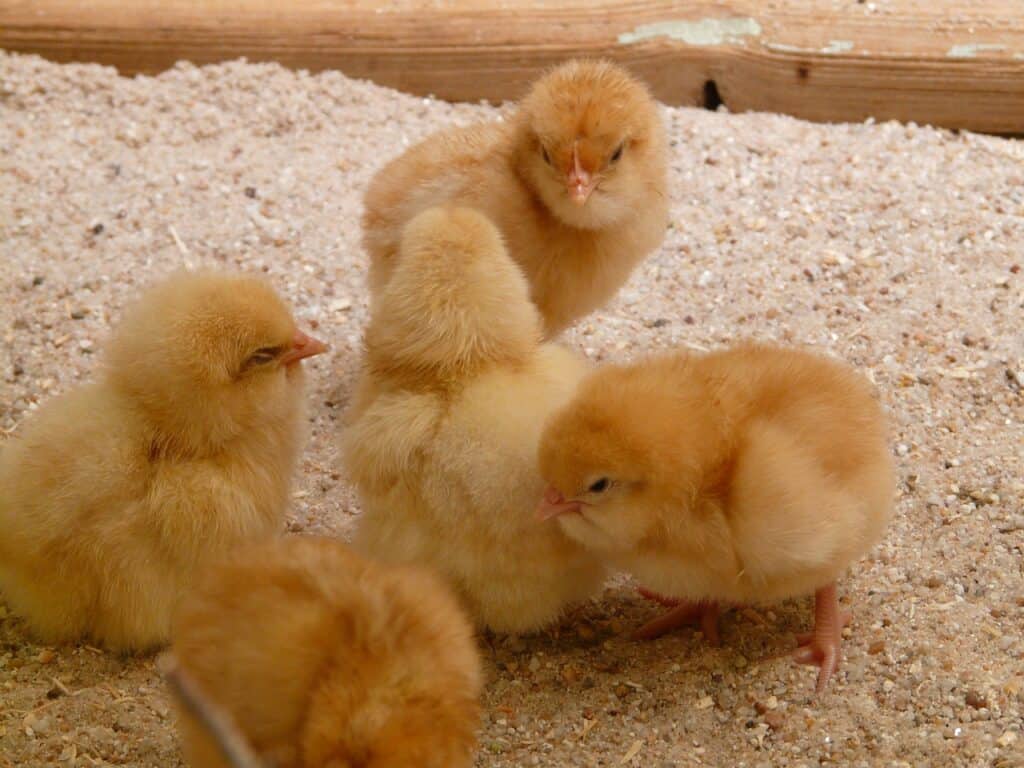The Beginners Guide to Caring For Your Baby Chicks
- First of all where can you find your new cute baby chicks? Well lots of places!
- There are a number of ways to go about getting chickens! Most often, chicks can be bought locally in the spring, from farm supply stores or small farms themselves. We usually get ours at a place called IFA Country Stores. These days, you can even order them online and have them sent to your home or just ask a friend if you can buy some of their soon to be babies 🙂
What Do I Need To Buy
- A draft free brooder pen
- A My Favorite Chicken Chick Brooder Heating Plate & Anti-roost cone Set warms up to 20 chicks – 22 watts (and Heat Lamp if you live some where like Utah for in the winters) you can get them from Walmart.com *** Heat lamps can cause fires so be very careful.
- Feeder (For Babies, I’d recommend one like the Harris Farms Hanging Poultry Feeder, this one is can be ground level easier for the babies to reach) (For Adults, I like the ones from Rentacoop)
- waterer (I like the ones from Rentacoop)
- Bedding (premium poultry bedding by mallard creek)
- Feed (chick starter by intermountain farmers)
- A full sized chicken coop and very large run or wide open space
- Toys
- Dust Bath and Sand
Your Brooder Pen, Coop, and Run
- For our brooder pen we use several things. 1st we use a great big bin that can hold all the food, water, warmer bed then as they get bigger we use a dog pen, like the basics Foldable Metal Pet Dog Exercise Fence Pen with Gate 60*64 in. I personally keep my babies in my garage until they are a couple months old. Its super cold and snowy in Utah until April so I want to keep them protected from the cold wind while they’re chicks. When things warm up and they are covered in feathers then they go in the co-op. Make sure they have bedding in the pen and food and water. Don’t give them food dish they can climb all over, knock down, or poop in. Find good ones that protect the food and water and them getting it gross. As suggested above we love the ones above.

- For your coop you can find endless coops online BUT do your homework! just cause its cute doesn’t mean it will survive your weather and climate. Also most do not provide adequate room for your chickens to roam. make sure chickens run is at least 3 sq ft per chicken inside and fro out side 8-10 sq ft. You should always put them in their coop at night to keep them safe from night predators (FYI my neighbor had problems with skunks digging in at night and killing his chickens. He learned that if you put an underground wall of fencing or cement all the way around about a couple feet deep the skunks give up digging they seem to tire out or get board. This has totally worked for him and no more killed chickens)
- With your coop I’d always recommend building one or having one built from someone you know. They will last forever if done right. You can even have them insulated to keep them warm in the winter. (mine is not and they’re fine but my bunnies and their babies do have insulated homes.)
- Keep their home CLEAN! Change bedding out monthly
Feeder, Waterer, and Heating
- Your feeder needs to be something that won’t be easily tipped over and can’t be pooped all over. These guys poop everywhere! We learned this the hard way. We like a feeder they can brood on and poop all over which is why we like the Rentacoop feeder but, for Babies, I’d recommend one like the Harris Farms Hanging Poultry Feeder, this one can be on ground level which is easier for those tiny fluff-ball babies to reach 🙂 It has a cone top so they have a hard time sitting on top and they have to put their heads in for food so they can spill it or poop all over it. Make sure they always have plenty of food.


- Waterer we learned the hard way they need a good water system that they can’t spill or contaminate cause they will do it every day! They are all over the place. So we love the Rentacoop one as well with the cone top so they can sit on it and cause it has the little spiel they can drink out of and they can’t get in it or spill it. Make sure they always have plenty of water.

- The heater DO NOT GET A HEAT LAMP UNLESS YOU HAVE TO! We have the coolest thing ever Chicken Chick Brooder Heating Plate & Anti-roost cone this is so cool the babies can all group together under it and it raises as they get older and taller! Once they are grown up even in the winter there are ways they will stay plenty warm with out needing a heating anything! They will adapt to what they’re use to. If you have winters like Utah you will need a heat lamp as well. Make sure to hang it somewhere safe to avoid fires. I tried to just use the chick heat pad and when they would come out to eat and drink they would freeze so fast that they lost their body heat so quickly. We had 5 die within days from each other. We added the heat lamp over where they get food and water and left the heat pad in as well, but a bit out of the heat lamps light so it didn’t get to hot under it. They all did amazing after that and we even added 7 more baby chicks. Sometimes they spread out under the heat lamp and some go under the heating pad. but now they have plenty of heat to give them a choice and to move around, eat, drink, and not freeze.
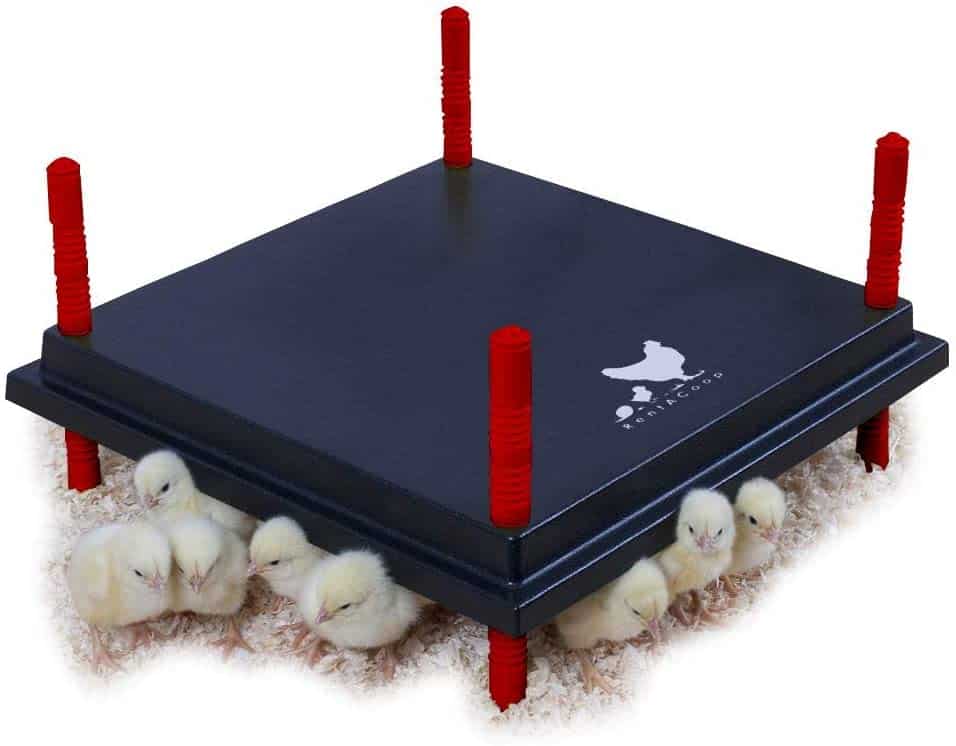
- Newly hatched chicks need to be maintained at 95°F for the first week of their lives. After the first week, chicks can tolerate temperatures 5°F cooler for each week until they are four weeks old. In other words, one week old chicks can tolerate 90°F and two week old chicks can tolerate 85°F. The easiest way to heat a homemade brooder is with a light bulb or heat lamp (see Figure 2). Suspend the heat source over the middle of the brooder. Observe the chick’ behavior to get the brooder temperature right: they will huddle up in the middle directly under the heat source if the brooder is too cold and move to the edge of the brooder away from the heat source if it is too hot. When the brooder is at a comfortable temperature, the chicks will move about freely throughout the available space.
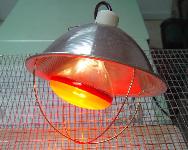
Feed and Bedding
- Your babies need the best nutrients so we use the chick starter by intermountain farmers then by 16 weeks we switch to the adult version. If you happen to find any fresh worms while gardening go ahead and let your chicken eat some 🙂 don’t feed them table scraps as babies (when adults if you do feed them table scraps grit would be good to add to help with digestions.)
- Bedding is an important part of keeping your chickens happy and healthy. On the coop floor and in the nesting box the bedding will provide a soft surface for your chickens to walk on and will absorb droppings and odor. You want your coop sanitary and sweet-smelling, don’t you? In the nest, bedding will give freshly-laid eggs a soft landing so they don’t crack. (A cracked egg is a spoiled egg.) Pine, Aspen, or HardWood shavings are best. Whatever you choose to use, the bedding in your coop should be at least 2″ thick–more is better. There are many bedding materials to choose from, but we do think the best litter is pine, aspen or hardwood shavings for indoor coops (not to be confused with wood chips or mulch). Shavings cost around $6.00-$9.00 per 35 pound “compressed” bag. These can be purchased at a pet store or farm and feed store like IFA.
Snuggles
- Your chicks need more then just food and water. They are so fun to snuggle. Let them play with you and be with you time to time. My mom built such a bond with her chick, it would follow her everywhere. So cute right. Another cute thing is any time she’d smile her chick would peck her teeth. 🙂 My point is they are so sweet and fun and they just love us. Chickens are the cutest and such fun pets so hold them lots as babies and they will love being with you as adults.
Pasty BUTT/BUM!
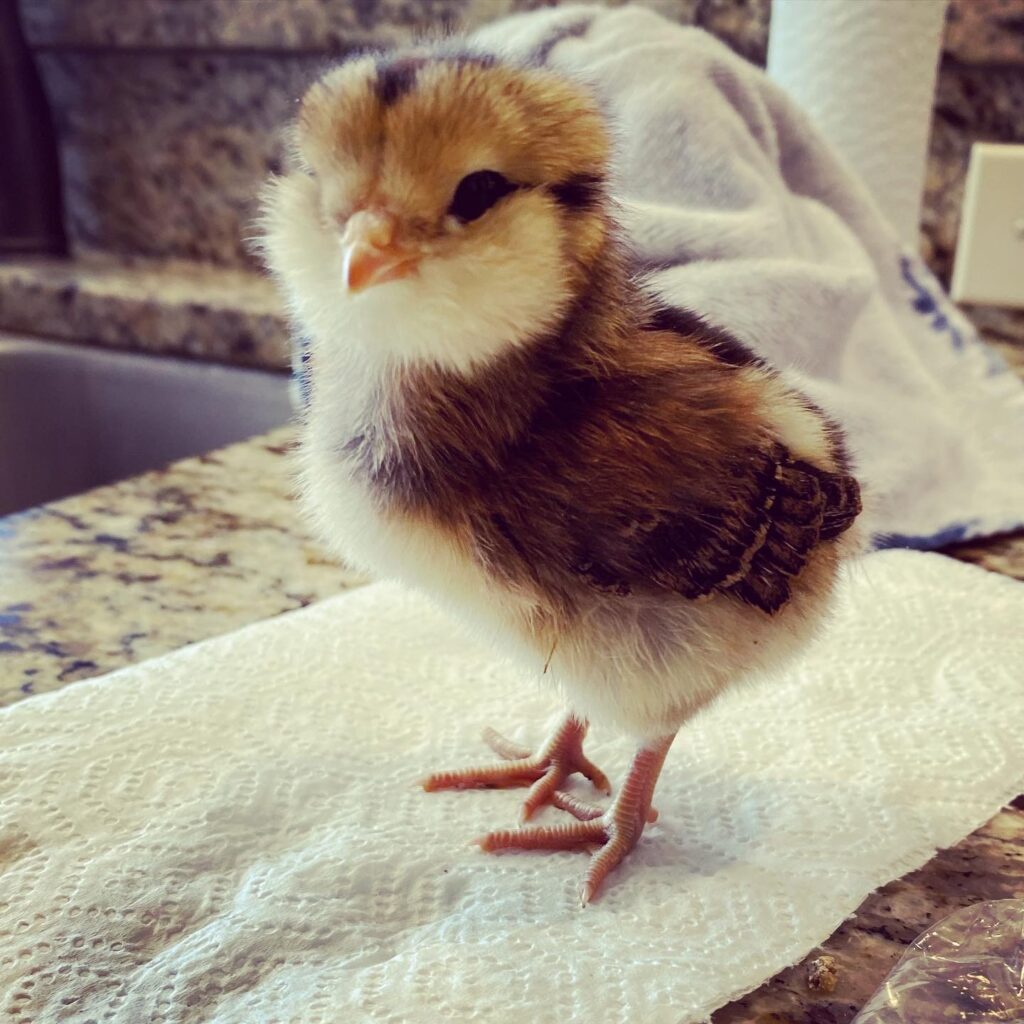
- Yes, you are reading this correctly! Baby chicks can get what is called Sticky Butt. This is something I am sad to say I only recently have learned about and it is why one of my newest baby chicks died. So what happens is as they poop, if it gets stuck to their bums it will start to harden. As it hardens more and more will get stuck, eventually causing the hole to be covered and clogged. The poop becomes like a cement. Well then as they continue to poop it gets stuck up inside and can’t come out. This then just like us humans can cause them to get very sick. Eventually kinda quickly they will die. It’s so sad.
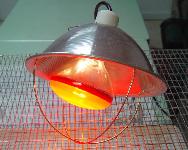
- How to fix this??? Its easy! Just pick them up, check their fanny and if it has poop on it get a paper towel wet with warm water and clean their Bummy off. But be careful you don’t want to tare anything or hurt them so just wipe soft and clean it off. After it is a good idea to dry it carefully with a blow dryer so they are fluffy again and so the other baby chicks won’t peek at the wet red spot. Then they are good to go. This will hopefully stop in a couple of weeks.
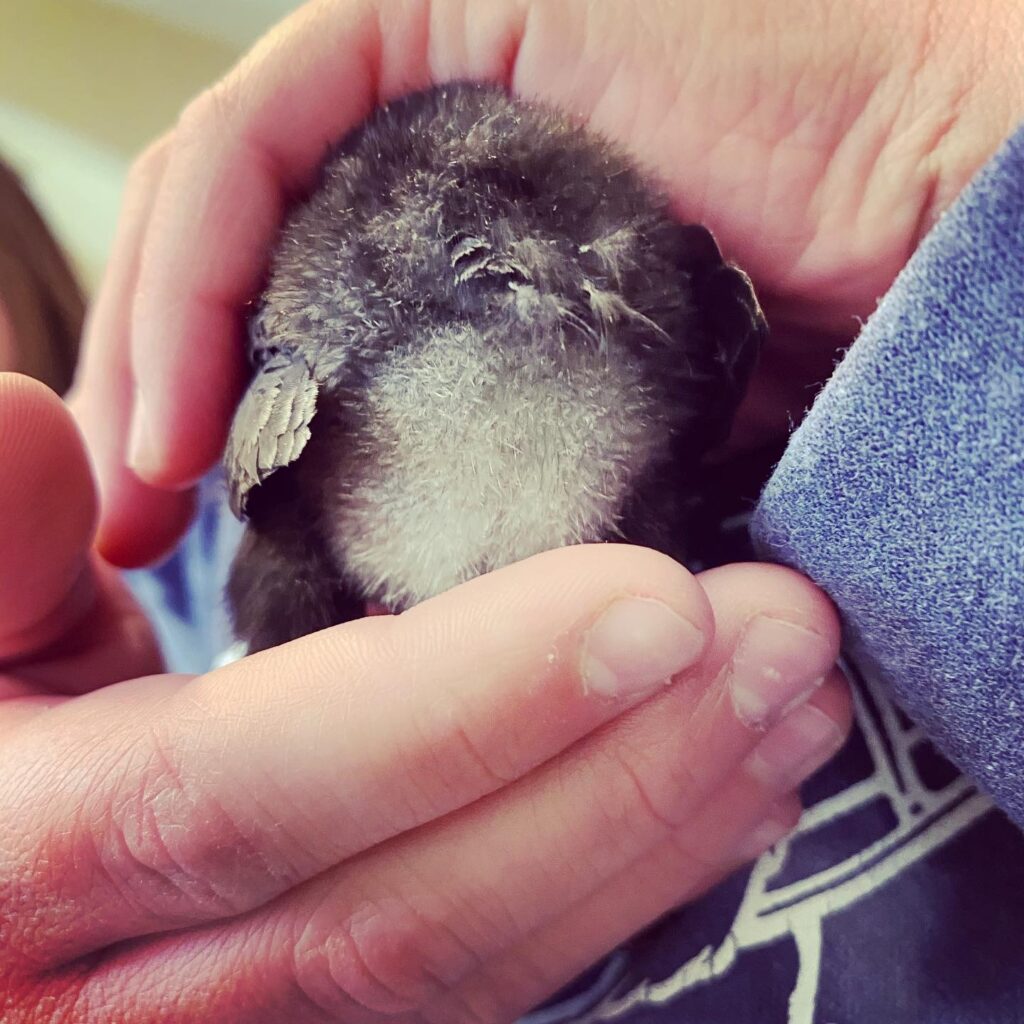
Toys and Dust Bath
- Chickens are every where and on everything. Get them toys! We have things for them to climb on like the “backyard barnyard chick perch” or the toy pack that comes with the hanging xylophone and hanging feeder, or a swing! They love swings.

- Chicken Dust baths are a must! This is their way of keeping clean. The fine sand or dirt in their bathing area keeps their feathers in pristine condition and helps them stay free of mites, lice and other parasites. Your chickens will enjoy bathing and sunning themselves and often bathe in groups. It seems dust bathing is a group activity! We use tires and paint them fun colors to match their cute coop. Get a couple tires what ever size you feel is best, and if you want get a good safe outdoor spray paint and paint them. Wait until dry before putting them in the coop. For your babies get a small bucket or bowl or something sturdy they can climb in with the sand and role around it.
- Fill the coop with sand (not dirt that will muddy up) use a good sand. If you are able even if you just use a tarp put a roof above the dust bath area so it doesn’t get wet as it will take for every to dry. Wood ash or charcoal is a wonderful addition to the dust bath area. Charcoal contains Vitamin K (a blood clotting agent), calcium and magnesium so those benefits will translate when your hens nibble on the wood ash as they bathe and rummage through the bathing area, as they are prone to do. Charcoal absorbs toxins and research suggests that after forest fires, wild animals will consume it for its medicinal properties. Charcoal is also a laxative and helps cleanse the body of toxins, as well as internal parasites, much like charcoal pills for humans. Never use briquettes or any wood that has had lighter fluid or other chemical coating on it.
Dried Herbs
Dried herbs sprinkled in the dust bath area can also be beneficial.
Dried lavender, mint, and rosemary are all good choices, as they are natural insecticides.
Dried anise, fennel, ginger, and seaweed also help repel parasites. Dried yarrow is an anti-inflammatory and helps clear respiratory systems as do thyme and rosemary.
Common Questions/FAQ About Chickens
- Question 1 How Do I Care For My Adult Chickens Needs?
- What type of Schedule should my chickens be on, what do they need.
- Question 2 What Illnesses Do I Need To Watch Out For With My Chickens?
- It is a good idea to educate yourself of what things to watch for and how to treat a sick chicken
- Question 3 How To Potty Train a Bunny
The Last Thing You Need to Know about Caring For Your Baby Chick
- Check on them often multi times a day
- Snuggle them, they love people and are so sweet, don’t just put them in a corner and ignore them.



